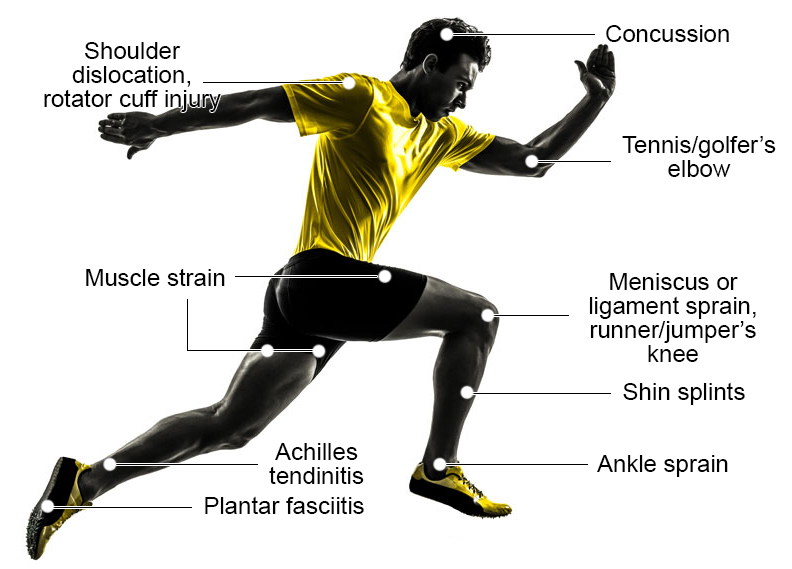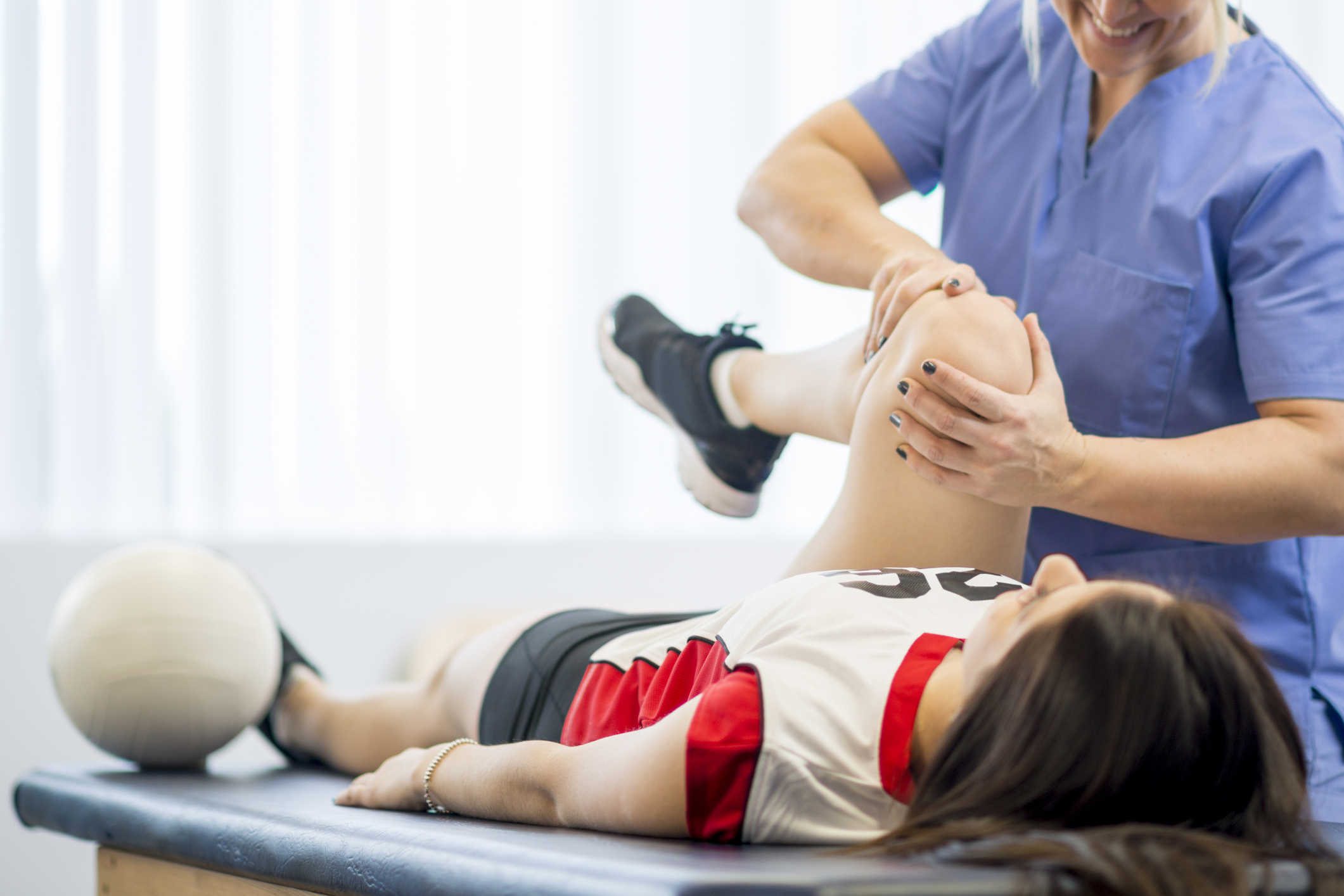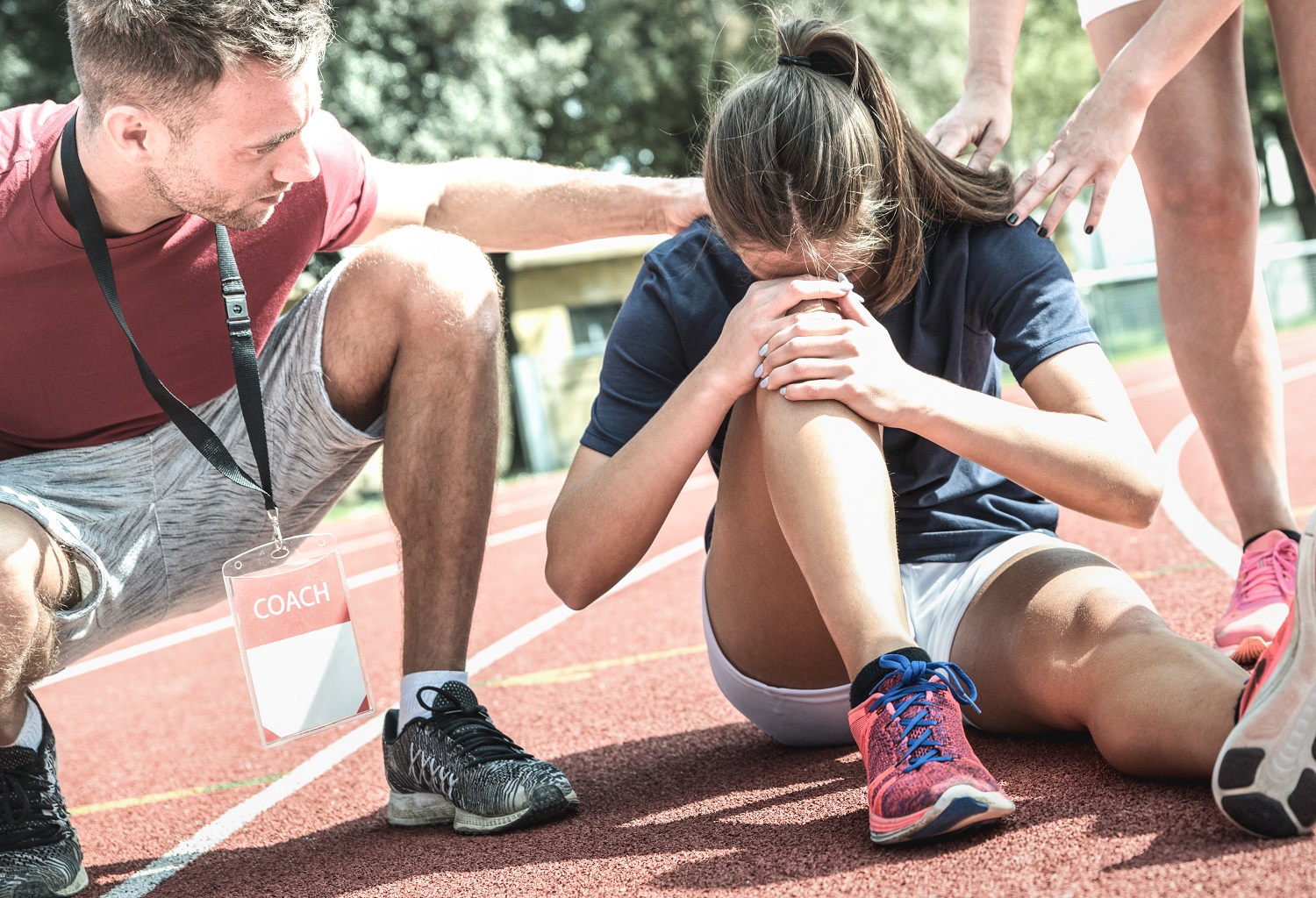If you’re an expert athlete or weekend athlete, if you participate in sports, you’ve probably suffered an injury at one time. The most frequent sports injuries are sprains, strains, swelling of muscles, ankle splints, injuries to the rotator cuff, fractures, knee injuries, and dislocations.
Certain sports-related injuries can be injury-related that result from sudden incidents, and can cause obvious symptoms. Other injuries are chronic conditions that can show more subtle symptoms in the beginning or gradually over time.
Common Sports Injuries

An injury in sports can result from accidents, impacts, poor training techniques, inadequate equipment or equipment, poor conditioning, or insufficient stretching or warm-up. The strains and sprains of muscles, tear of muscles and ligaments, joint dislocations, bone fractures, head injuries are all common.
Although joints are more susceptible to injury from sports, every part of your body is susceptible to injury when playing on the field or court. Here’s a closer look at the most common injuries suffered by various body parts.
Head
The most commonly-reported athletic head injury is the concussion–an injury to the brain caused by an injury on the head collision and violent shaking. A concussion is regarded as a trauma to the brain that can impact cognitive function. Concussions that are repeated can lead to long-term issues with executive functioning. If you suspect that you or someone you know is suffering from a concussion, get medical care.
Shoulder
The most frequent shoulder issue is an injury or tear of the rotator Cuff. However, other issues like the frozen shoulder or tear of the labrum may mimic the signs of an injury to the rotator tendon. They must be evaluated as a possible diagnosis.
Elbow
Tendon issues in the elbow area, such as epicondylitis lateral (tennis elbow) and medial epicondylitis (golfer’s elbow), are the most frequent sports-related issues that affect the joints of your elbow.
Wrist
The wrist fracture is among the more frequently broken bones among athletes. A fall that causes a fracture to an untidy arm, for instance, can cause a wrist fracture which requires intervention.
Finger
Jammed fingers may refer to different kinds associated with sports hand injuries. Finger joint dislocation and swelling of the fingers are typical, especially when playing ball sports such as soccer and basketball.
Spine
Muscle strains in the low back are among the most frequent injuries to the sport’s spine (or those who do not compete). The pain is usually extreme and deep, which can cause people who suffer from it to think that a serious structural issue may have developed. Although other spine-related issues ought to be considered, lumbar strains are the most prevalent of them.
Hip and Groin
Strains in the groin and pulls have long been a frequent Hip pain diagnosis. Many hip issues were once thought to be due to an injury to muscle like femoroacetabular impingement or F.A.I. And ruptures of the labrum are now being recognized. However, injury to the groin is the most prevalent.
Thigh
A muscle pull, strain, or tear could occur in the hamstrings and the quadriceps and adductor muscles of the thigh due to many different activities. Hamstrings and quadriceps are vulnerable during high-speed sports such as track and field basketball, football, and soccer. The injury is caused if the muscles are stretched to their limits, which tears the muscle’s fibres.
Knee
Anterior knee pain, often known as patellofemoral pain syndrome, is a type of cartilage inflammation on the lower side of the kneecap, which causes discomfort and grinding. Exercises for rehabilitation are often utilized as therapy.
Ankle
Ankle injuries are the most commonly occurring injuries to the joint of your ankle. After an ankle sprain has been sustained, repeated injuries may be quite common. Rehab after injuries can prevent reinjuring your ligaments of the ankle.
Foot
Plantar fasciitis can be caused by irritation of the hard, dense tissue that forms your foot’s arch. The plantar fascia tendon may be painful and contract, which can cause problems when getting onto the heels of your foot.
Causes
Sports injuries generally are classified into two types, chronic or acute. They could result from direct impacts, overloading (putting more pressure on a joint than it can handle), or even overuse. 11
An acute injury is caused by an incident or accident that causes visible symptoms. For instance, a fall, slip, or tackle can cause an acute injury. While some accidents are an element of playing sports, some can prevent them by using the right equipment and gear while playing with safety in mind. For instance, playing soccer in slippery leaves can result in falling and slipping.
A long-term injury is more long-lasting. It can start as an acute injury that doesn’t heal fully or is caused by excessive use or improper technique. A lot of athletes endure discomfort, which could cause chronic injuries.
Symptoms

The symptoms of a sports injury are often apparent rapidly at the time of injury or can develop slowly over just a few hours or days. If an athlete has hard falls, sprains an ankle, or is injured, The typical reaction is to try to get it out and continue to push through the pain. That could cause long-term issues.
Signs of a chronic overuse injury can develop as time passes. However, acute flare-ups of older injuries are common. The signs of a sports injury are as follows.
Pain
The most common symptom is pain. Of a sporting injury. It is the body’s sign that something is wrong. It may differ depending on the nature of the injury.
The moment you feel pain due to an acute injury that cannot heal is best treated by a doctor who specializes in sports. One example is the ankle being rolled and not being in a position to put pressure on it, or colliding with another person or other object and not being in a position to move your arm.
Sometimes, the onset of pain occurs later. That is especially frequent in injuries sustained from overuse. Joints may be a bit tender right away following a sporting event. However, the discomfort continues to get worse with time. A feeling of tenderness after applying pressure to the area could indicate that there is a serious injury that occurred.
The site of discomfort, the extent of the pain, and a description of the kind of pain you’re experiencing will help your healthcare professional determine the root of the problem.
Swelling
Swelling can be a sign of inflammation. The body attempts to heal injuries and trigger the healing process of your immune system. Although swelling isn’t necessarily undesirable, it can be uncomfortable.
In the initial stage following an injury, you might not be able to notice any swelling or a limitation in the movement. The swelling usually occurs slowly as healing fluid and blood are released to help heal and protect damaged bone or tissue.
The symptoms you experience could inform your doctor about the type of injury that you’ve sustained. There are several kinds of swelling.
- Effusion: Swelling within a joint
- Edema The swelling of the tissues in your soft
- Hematoma: The swelling is because of bleeding in the soft tissue
Stiffness
Although pain is difficult to measure, mobility can determine by measuring the range of motion you have. That is particularly true for injury to the limb since you can look at the joint in pain and the healthy counterpart.
A restricted range of motion may be an indication of the degree of injury. A rest period is usually recommended in the case of an inability to move in the case of acute injuries. It is followed by gentle exercises that progress to more training. Consult a sports physician or physical therapist for a thorough assessment and treat any mobility issues before returning to sports.
Instability
A joint in instability is prone to slipping or feeling like it’s about to give way or loosen. That can be the sign of an injury to the ligament (like one that is an A.C.L. tear) since the joint injured isn’t properly supported after it’s been injured.
Weakness
A sprain that reduces the strength of an injured region could indicate an injury to the structure of the muscle or tendon, which hinders normal functioning. The limitation in your ability to lift the arm or even walk due to weakness must be assessed by a physician since many other causes may be troubling.
Numbness and Tingling
Tingling or numbness is an indication that there is a nerve injury or irritation. Sometimes, nerves can be directly damaged; in other instances, nerves may be inflamed by the surrounding inflammation or swelling. The slight tingling of the limbs is not usually an issue, but being unable to sense the injured part is a greater worry.
Redness
The redness on the injury site may be caused by swelling or an allergic reaction, abrasion, or an infection. If you experience unexplained skin redness, especially when the area is extremely hot, you must be examined by a doctor.
Confusion or Headache
Even a minor head trauma can result in concussions, which could cause cognitive issues that include confusion, difficulty in concentrating and memory issues, and headache, nausea, dizziness, and irritation.
Concussions can have severe consequences and should never be overlooked if head trauma results in immediate symptoms (or loss of awareness); take medical care, even if the symptoms disappear.
When to See a Healthcare Provider

Injuries from sports are not uncommon, and visiting a medical specialist for every ache and discomfort isn’t necessary or feasible for most athletes. If you’re suffering from an injury that isn’t getting better with simple treatment methods, but it’s worsening despite all your efforts, consult a qualified & professional Sports Physiotherapist.
A few signs that you need to be evaluated by a physician are:
- The injured area is often difficult to use (walking or lifting your arm, etc.)
- Inability to support the weight of an extremity
- Joints with limited mobility
- The injured area is deformed.
- Bleeding or skin injury
- Indications of infection (fevers, chills, sweats)
- Headache, dizziness, or confusion and loss of consciousness after the trauma to the head
Diagnosis
A physician assesses injuries that are chronic and acute for sports or orthopedists. However, non-physician specialists trained to identify and treat these injuries, such as athletes trainers and physical therapy–may be able to do the same.
You’ll have to provide the medical history of your doctor and details regarding the cause of your injury and then be examined for physical injuries.
In your physical exam, the healthcare professional will feel the area and inquire about the level of tenderness or pain. You’ll be asked to move the area of injury to check its motion range and.
For the suspected injury, as well as the severity of disability or pain, your doctor may recommend an X-ray to rule out fractured bones. While some fractured bones are obvious on the initial scan, others (e.g., an easy wrist fracture or hairline fracture on foot) are not apparent until after a few days when healing has started.
Other diagnostic imaging tests can be ordered to identify soft tissue damage. These tests can be scheduled in the initial appointment or after treatment is unsuccessful and include the following.
- Magnetic resonance imaging (M.R.I.): This is frequently utilized for diagnostic imaging. For diagnosing joint injuries, muscle injuries, fractures, sprains, and head injuries sustained in activities. M.R.I.s use radio waves in an intense magnetic field to look at the musculoskeletal system structures that include muscles, bones, tendons, ligaments, nerves, and muscles.
- Ultrasound Used to assess tendon injury; with Ultrasound, the sound waves create real-time pictures of the superficial soft tissues. When you undergo an ultrasound radiology exam, the doctor might require you to move your joint to determine how movement can affect the tendon.
- Computed Tomography (C.T.) scans The CT scan gives a more precise examination of bones and soft tissues. This test can reveal hairline fractures, as well as minor imperfections within complex joints.
Treatment
The treatment you receive will depend on the site and the severity of the injury. The initial treatment for many injuries to the body is focused on minimizing inflammation and stimulating the healing process.
Its acronym R.I.C.E. can be a useful guideline for the prompt treatment of acute injuries. If you’re doing R.I.C.E. treatment, you’ll need to follow this sequence of steps
- Relax: Limit the forces acting on the area of injury of your body. That usually means cutting off your sporting activity, which could mean using crutches, a sling, or other means to take a break from the region.
- Ice It is beneficial to reduce inflammation and swell as well as assist in the reduction of pain. Many athletes who apply ice to an injury realize that they don’t require pain medications to ease discomfort.
- Compress is done by wrapping the body snugly but not tightly, covering the area of injury on the body in an elastic bandage. Tighter compression can lead to the worsening of your symptoms, as well as other issues.
- The Elevate method: Elevating the injured extremity will also reduce inflammation and swelling. That can consequently lessen the pain.
After a period of initial rest, it must replace with the protection of optimal load. That is called P.O.L.I.C.E. (protection of the most optimal load, compression, and elevation). The joint can be protected by the aid of a device like crutches or a sling; moving the joint gently and gradually placing weight on the injury can typically speed up the healing process. 18
Using P.O.L.I.C.E. to help with Recovering from Injury
After the initial healing process, the healthcare professional will decide is the extent to which additional treatments are required and recommend you to an expert to treat your particular injury.
The treatment options for sports injuries are:
- Immobilization using a splint or brace, or cast
- Pain medication
- Injections to relieve pain, for example, cortisone shots
- Physical therapy
- Surgery
A Word From Verywell
The thought of taking a time-out from your routine (and possibly loved) sport can be difficult to accept. However, the risk of letting an injury from sports go untreated can leave you for longer or stop the return to sport completely. Please pay attention to your body’s signals and seek out professional assistance when you require it.
